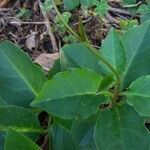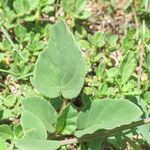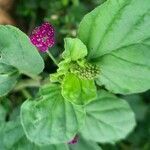Herbs, perennial [rarely appearing annual], sometimes slightly woody at base; taproot fusiform, woody. Stems decumbent, ascending, or erect, usually profusely branched throughout, 3-10 dm, glabrous or minutely pubescent basally, glabrous or sparsely pubescent distally. Leaves mostly in basal 1/2 of plant; larger leaves with petiole 10-30 mm, blade broadly lanceolate, ovate, or broadly ovate, occasionally ± round, 20-60 × 15-50 mm (distal leaves smaller, often proportionally narrower), base truncate, broadly cuneate, round, or shallowly cordate, often oblique, margins sinuate, apex obtuse to round, abaxial surface paler than adaxial, glabrous or minutely puberulent, sometimes glandular, usually with few large multicellular hairs on veins, adaxial surface glabrous, rarely sparsely puberulent, neither surface punctate. Inflorescences terminal, forked ca. 3-6 times ± equally, diffuse, occasionally with sticky internodal bands; branches divergent, terminating in compact subumbellate or capitate, 2-5-flowered clusters. Flowers: pedicel shorter than 0.5 mm; bract at base of perianth quickly deciduous, 1, lanceolate, 0.8-1 mm; perianth purplish red to reddish pink or nearly white, campanulate beyond constriction, 1-1.5 mm; stamens 2-3, included or barely exserted. Fruits (1-)2-5(-9) per cluster, gray-brown to brown, obpyramidal, (3-)3.5-4.5 × 1-1.2 mm (l/w: 2.8-4.1), apex broadly conic, with sparse or moderately dense stipitate-glandular hairs on ribs, less densely pubescent or glabrous in sulci [rarely entirely glabrous]; ribs 5, round, smooth; sulci ± 2-2.5 times as wide as base of ribs, not rugose, not papillate. 2n = 26, 52, 54, 116.
Perennial herbs; stems decumbent to ascending, 4-12 dm. long, rather slender, more or less viscid-puberulent. Leaves opposite or subopposite, often unequal at the nodes, petiolate; blade orbicular to rhombic-ovate below, frequently grading to lanceolate above, obtuse to rounded or acute at the apex, obtuse to rounded at the base, undulate or sinuate, 2-6 cm. long, 2-5 cm. broad, more or less puberulent to glabrate, yellowish green above, paler beneath, not punctate; petiole 1-4 cm. long. Inflorescences paniculiform, lax and many-flowered, leafy-bracteate at least below, viscid-puberulent to glabrate. Flowers in pedunculate glomerulate clusters, sessile or subsessile, the perianth tube 0.7-1.0 mm. long, somewhat less than 0.5 mm. broad, herbaceous, minutely glandular, the perianth limb campanulate, about 0.5 mm. long, red to purple, rarely white; stamens 3, slightly exserted. Anthocarps obovoid to subellipsoid, obtuse to obscurely beaked, 3-4 mm. long, 1 mm. broad, glandular, sessile or subsessile.
Stems decumbent, diffuse or prostrate, glabrate to puberulous. Leaves with petioles (8-)10-30(-33) mm long; lamina elliptic, lanceolate, ovate, oblong, orbicular or obovate, (18-)21-58(-61) x (11-)13-40(-46) mm; apex apiculate, acuminate, rounded or obtuse; base shortly attenuate or obtuse; margins entire, sometimes undulate; glabrous with long septate hairs along margins and scattered along veins. Inflorescence with primary peduncles 60-150 mm long, secondary peduncles 25-60 mm long, glabrate, 2-5 flowers per cluster; pedicels 1 mm long Flowers 2-3 mm long; lower part of perianth 1 mm long, ellipsoid-clavate, 5-ribbed, glandular hairs present; upper part of perianth 1-2 mm long, pink, purple or maroon. Stamens 2 or 3, slightly exserted, 1.5-2.5 mm long. Ovary 0.5 mm long; style 1-1.5 mm long. Anthocarp 3-4 x 1-2 mm, ellipsoid-clavate, 5-ribbed, ribs indented near apex, apex ending in pointed tip, glandular hairs present on ribs.
Annual or perennial, prostrate, ascending or erect herb up to 1 m., sometimes with a thick taproot.. Stems fleshy, becoming woody towards the base, green, sometimes tinged purple, branching mainly from the base, the nodes swollen, glabrescent to puberulous with long septate hairs especially around the nodes.. Leaves broadly ovate to lanceolate, up to 6×5 cm., green, paler beneath, the base truncate to cuneate, the apex rounded to acute, with long septate hairs on the sinuate margins and veins beneath.. Inflorescence a large diffuse terminal panicle up to 35 cm., the individual cymes (1–)3–5(–7)-flowered; branches glabrous to glabrescent.. Perianth 1.5–2.5 mm. long; upper portion pink to purple, 1–1.5 mm. long.. Anthers 1(–3), slightly exserted.. Ovary ± 0.5 mm.; style slightly exserted.. Anthocarp obovoid, 3–4×1–1.5 mm., 5-ribbed, rounded at the apex, glandular-pubescent.. Fig. 1/1–4.
Herb, 0.4-1(-2) m, erect, ascending, creeping, climbing, puberulous glabrescent with club-shaped or stalked glands and glandular hairs, rarely hirsute. Leaves ovate-lanceolate, beneath often white, sometimes with red marginal glands, ½-4 by ¼-4 cm; base obtuse, cordate, or truncate; top acute to obtuse or obtusely acuminate; petiole 1-3.5 cm. Flowers 1-12 together, campanulate, in cymose panicles, 0.5-7 by 1-6 cm; peduncle 2-5 cm, 1-3 times branched. Pedicel 0.25-2 mm; bracteoles 1-3, lanceolate, 0.9-1 by 0.25-2.5 mm. Perianth 1.5-2.25 mm, with a distinct constriction halfway, limb 1-2 mm, white, red, pink, or violet. Stamens 1-3, exserted up to 0.5 mm. Stigma exserted up to 0.5 mm. Anthocarp club-shaped, 2.5-3¼ mm, with 5 ribs, with scattered, club-shaped, stalked or sessile, minute glands.
Herbs perennial. Stems trailing, to 200 cm; stems glabrous or sparsely pubescent. Roots thick, fleshy. Petiole 0.4-2 cm; leaf blade ovate, 1-5 × 1-4 cm, both surfaces sparsely pubescent, abaxially gray-yellow, wrinkled when dry, base rounded or cuneate, margin undulate, with stout, muticellular hairs, apex obtuse or acute. Inflorescences terminal, capitate-cymose panicles; peduncle slender, sparsely pubescent. Pedicel short to almost absent. Bracts small, lanceolate, pubescent. Perianth limb bright purple or purple-red, 1.5-2 mm. Stamens 1-3(-5), slightly exserted or included. Anthocarp clavate, 3-3.5 mm, 5-ribbed, with viscid glands and sparse pubescence, apex rounded. Fl. and fr. spring-autumn.
A weedy evergreen vine or shrub which lays over. It grows to 70 cm high. It spreads about 50-200 cm wide. The stem is slender, creeping and twining. It has a large root system. The leaves are dull green and in opposite unequal pairs. They are 1-2.5 cm long by 1-2 cm wide. The lower leaves are broadly oval while the upper leaves are more narrow. The edges of the leaves are wavy. The flowers are yellow and white or pink. They occur in groups of 3 at the ends of branches. They are 0.5 cm long. The fruit are about 0.4 cm long. They have glands that make them sticky. In a similar plant Boerhavia erecta the fruit are smooth and not sticky.,
Annual or perennial, subglabrous or glandular-hairy herb; stems decumbent to erect, to 80 cm high. Leaves: lamina ovate or elliptic, to 6 cm long, usually sinuate, obtuse or acute, ± oblique; petiole to 2.5 cm long. Inflorescence terminal, compound, diffuse, to over 60 cm long; basic unit a 3–10-flowered glomerule or umbel c. 7 mm diam. Perianth glandular-hairy throughout; limb campanulate, 2–3 mm long, bright purple-pink. Stamens 2 or 3. Fruit ellipsoidal to clavate, c. 4 mm long; ribs 5, prominent, glandular-hairy, sometimes sparsely so; furrows narrow, not glandular-hairy.
Leaves 1.5–6 × 0.8–5 cm., ovate, elliptic or subcircular, base subcordate, rounded, more or less truncate or broadly cuneate, apex acute to rounded, sometimes apiculate, usually more or less glabrous with long septate hairs mainly along veins below and margins; petioles to 4 cm., glabrous to puberulous, often with long septate hairs.
Prostrate herb. Stems glabrous. Leaves broadly ovate, young leaves fringed with long septate hairs, otherwise glabrous. Inflorescence a lax, much-branched cyme. Fruit glandular. Flowers deep purple.
Inflorescences elongating greatly after start of flowering, ultimately lax, terminal, leafless, cymose panicles, occasionally a few scattered simple axillary cymes, branches glabrous.
Stems spreading, decumbent with ascending flowering stems to 1 m., diffusely branched, glabrous to puberulous, often with long septate hairs particularly around nodes.
Perianth 1.6–2.5 mm. long, lower portion 5-ribbed, glandular-pubescent, upper portion 0.5–1.2 mm. long, campanulate, whitish, pink, carmine or purple.
Bracteoles more or less 1 mm. long, ovate to lanceolate, acuminate, margins fimbriate.
Ovary more or less 0.5 mm. long, glabrous; style 1–1.5 mm. long, slightly exserted.
Flowers usually 2–7 (11) per cluster, sessile or with pedicels to 1 mm. long.
Anthocarps 3–3.5 × 1–1.75 mm., clavate, apex rounded, glandular pubescent.
Stamens 1–3, subequal, slightly exserted 1.5–2.5 mm. long,.
Perennial herbs, usually much branched from base.







